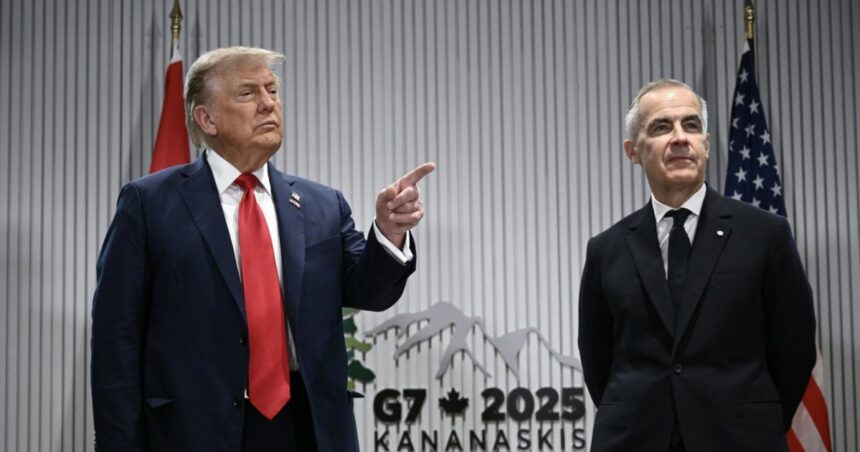As the G7 summit approaches, the relationship between the United States and Canada faces renewed scrutiny after former President Donald Trump and Canadian Prime Minister Mark Carney held their first face-to-face meeting yesterday. The encounter, which took place at Trump’s Mar-a-Lago estate, touched on critical issues from tariff threats to Russia-Ukraine policy, setting the stage for what could be a transformative shift in North American relations.
“We’ve had our differences in the past, but I believe we can work toward solutions that benefit both countries,” Trump stated during the brief media availability. The meeting comes as Trump’s campaign repeatedly floats the possibility of imposing a 25% blanket tariff on Canadian goods should he return to office.
Carney, the former Bank of England governor who entered politics just months ago, appeared measured in his response. “Canada and the United States share the world’s most successful economic partnership,” he emphasized. “Our supply chains are deeply integrated, and disrupting that relationship would harm workers on both sides of the border.”
Behind the diplomatic language lies significant tension. According to sources familiar with the talks, Carney arrived with economic data showing that Trump’s proposed tariffs would cost American consumers an estimated $18 billion annually and potentially eliminate 120,000 U.S. manufacturing jobs. The Canadian delegation specifically highlighted the interdependence of the automotive sector, where parts often cross the border multiple times before vehicle completion.
Trade wasn’t the only contentious topic. The meeting also revealed daylight between the two leaders on Russia policy. While Carney has maintained Canada’s steadfast support for Ukraine, including a recent announcement of $3.5 billion in additional military aid, Trump has repeatedly expressed skepticism about continued Western involvement.
“We discussed approaches to ending the conflict in Ukraine,” Carney noted carefully after the meeting. He avoided directly criticizing Trump’s previous statements praising Russian President Vladimir Putin, instead emphasizing “the importance of standing with allies against territorial aggression.”
Energy policy created another flashpoint. Alberta’s vast oil reserves – the third-largest proven crude reserves globally – have long been central to U.S.-Canada relations. Trump reportedly pushed for increased pipeline capacity and criticized the Carney government’s carbon pricing mechanisms.
“They’re sitting on tremendous wealth in Alberta,” Trump remarked. “But they’ve got all these regulations holding them back.”
What made this encounter particularly significant was its timing before the upcoming G7 summit in Italy, where leaders will grapple with global economic fragility and security challenges. The summit represents Carney’s debut on the world stage as Prime Minister, having assumed office after Justin Trudeau’s surprise resignation triggered elections earlier this year.
For Canadians watching anxiously, the meeting carried existential stakes. With 75% of Canadian exports heading to the U.S., any major policy shift could send shockwaves through their economy. In border communities like Windsor, Ontario, where thousands cross daily to work in Detroit’s auto plants, Trump’s tariff rhetoric has created palpable anxiety.
“We’re completely intertwined,” explains Martine Leblanc, who owns a small auto parts manufacturing company in Windsor. “If these tariffs happen, I’d have to lay off at least half my workforce.”
The meeting also revealed the complex calculus facing Carney, who must balance standing firm for Canadian interests while avoiding antagonizing a potential future president known for taking policy disagreements personally.
Defense spending emerged as another point of contention. Trump has long criticized NATO allies, including Canada, for not meeting the alliance’s 2% of GDP defense spending target. While Carney recently announced plans to increase military expenditures, Canada’s current spending remains around 1.3% of GDP.
The two leaders did find common ground on China policy, with both expressing concern about Beijing’s trade practices and intellectual property protections. This alignment suggests potential cooperation on efforts to reshore critical manufacturing and reduce dependence on Chinese supply chains.
As delegations from both countries prepare for the G7 summit, the Trump-Carney meeting has established the parameters of what promises to be a complex relationship. While avoiding open hostility, the underlying tensions on trade, energy, and global security remain unresolved.
For Carney, navigating this relationship represents perhaps his greatest test since transitioning from central banking to electoral politics. For Trump, Canada policy offers a window into how he might approach international relations should he return to the White House – balancing transactional diplomacy with longstanding alliances.
What’s clear from this initial encounter is that the stability of the world’s most extensive bilateral trading relationship may depend on finding compromise between Trump’s “America First” instincts and Carney’s defense of the integrated North American economy that has developed over generations.






